[四国EPO・四国ESDセンターが、みなさんにおすすめしたい!と思った事例をご紹介していきます]
徳島県学生地球温暖化防止活動推進員による「いろどり屋」の取組 / Tokushima Prefecture’s Student Advocates ‘ “Irodori-ya” Initiative / 由德岛县学生地球变暖防止活动推进员组成的“Irodori屋”活动
徳島県学生地球温暖化防止活動推進員とは、徳島県内大学・大学院の学生が集まり地球温暖化防止のため、各種イベントの企画や運営、普及啓発活動を行っている。学生推進員になるためには徳島県地球温暖化防止活動推進センターで登録を行い、同センターが実施する事前研修を受講する必要がある。現在、徳島県で活動している推進員は77名。その中でも今回はリユースについて活動を始めた「いろどり屋」を紹介する。
「いろどり屋」はまだ使えるモノの新しい持ち主を探すリユースイベントで、エコみらいとくしま敷地内エコモデルハウス「ZEH」内にて一日限定でリユースショップを2024年2月17日にオープンさせた。取扱いは衣類、帽子、アクセサリー、食器などで、来店者は無料で必要な分だけ選んで自由に持ち帰るシステムだ。また、日常生活で使わなくなったものを持ち込むことも可能で、モノを循環させる仕組みを作っている。しかし、衣類は洗濯してから持ち込んでもらうことや、汚れがひどいものや壊れているものは引き取らない。帰り際に持ち帰りたいものの重さを計測し、廃棄物の削減量を可視化している。




「いろどり屋」ではワークショップも同時開催しており、今回はごみになりがちな糸くずや余ったビーズ、ネイルのパーツ、古着のはぎれ、貝殻などを使って世界に1つだけの時計やアクセサリーを製作した。参加者はボタン、ビーズ等を持参することも可能だ。子どもから大人まで参加でき、針でボタンをつけることが難しい方は布用のクレヨンで絵を描くなどして、誰もが楽しめるワークショップになるよう工夫がされていた。
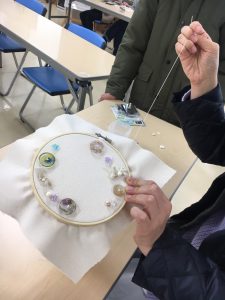

このイベントを企画した学生推進員に、この企画を思いついたきっかけを尋ねると、「片付けがとても苦手で物に溢れた生活をしていた。そんなときに訪れた上勝町でくるくるショップの活動内容を知り、地域から不用品を持参できる場所を作りたいという思いが強くなり、今回のイベントを思いついた。」と話してくれた。イベントに向けて、商品の回収時に衣服にタグがついているものや使用していない食器類が大量に持ち込まれるのを目の当たりにし、購入者は新品が欲しいのではなく、目新しいものが欲しいのではないかということに気づき、自分自身も買い物をするときに本当に必要かどうかを立ち止まって考えるようになったという。
最後にこのイベントをきっかけに、「モノを大事にすること」「工夫次第で廃棄されるものが使えるようになること」を知ってもらいたいと、強いメッセージを送ってくれた。開催に協力した徳島県地球温暖化防止活動推進センターの担当者は、学生推進員と取組を進める中で、学生の主体性が高まり、我々では考えつかない企画案がたくさん出てくるようになったという。地域課題解決を進める上でもこの制度は人材育成につながる良い仕組みだと話してくれた。
徳島県内の学生が主体となって取り組む「いろどり屋」の活動が、多くの人に環境配慮を自分ごととして考え、購入するときには長く使えるものか考えるきっかけとなること期待したい。
Tokushima Prefecture’s Student Advocates ‘ “Irodori-ya” Initiative
Tokushima Prefecture’s Student Advocates for Climate Change Action are a group of university and graduate students who plan and manage various events to spread awareness and stop climate change. To join them, it is necessary to register at the Tokushima Center for Climate Change Action, and receive their pre-service training. Currently, there are 77 of these advocates active across Tokushima. In this article we will introduce one of these advocates, “Irodori-ya,” which began activities focused on reuse.
“Irodori-ya” is a reuse event that seeks to connect still-usable items with new owners. On February 17, 2024, it opened a one-day-only pop-up shop operating out of the ZEH Eco Model House at Eco Mirai Tokushima. The shop handles various items, including clothing, hats, accessories, and tableware, and allows visitors to take home whatever they need at no cost. It is also possible to bring in daily items that are no longer needed, resulting in a circulation of goods. However, clothes must be washed before being brought in, and items that are too dirty or broken are not accepted. Items taken home by a visitor are weighed first, in order to visualize the reduction in waste.




There are also workshops held at “Irodori-ya.” The most recent one involved making one-of-a-kind clocks and accessories out of a prepared selection of waste thread, leftover beads, nail art parts, scraps of old clothes, seashells and other items that have a tendency to get thrown out as trash. Participants could also bring their own buttons, beads, etc. he workshop was designed to be enjoyed by participants of all ages, with alternatives like drawing with fabric crayons available for those who found sewing buttons with thread to be too difficult.


When asked about the inspiration behind this event, the student advocate who planned it said, “I was very bad at tidying up and lived in a cluttered environment. At that time, I visited Kamikatsu and learned about the Kurukuru Shop, I was overcome with the desire to create a place where people could bring unwanted items from their community. That was where the idea came from.” When collecting unwanted goods to prepare for the event, she was surprised to see much of what was being brought in was clothes with the tags still attached and unused tableware. It made her realize that what buyers want is new things, but novel ones, and prompted her to be more considerate about what she really needs when shopping.
Finally, the student advocate had a strong message about what she hopes people learned from the event: namely, the importance of valuing things, and that with a little ingenuity, items destined for disposal can be made useable again. A representative from the Tokushima Center for Climate Change Action who helped run the event commented that working with student advocates has increased the students’ initiative, resulting in many innovative proposals that the Center hadn’t thought of. The system is seen as a good mechanism for human resource development while simultaneously contributing to the resolution of regional issues. It is hoped that the activities of “Irodori-ya,” led by students in Tokushima Prefecture, will encourage many people to consider environmental concerns as their own and think about the longevity of items before making a purchase.
由德岛县学生地球变暖防止活动推进员组成的“Irodori屋”活动
德岛县学生地球变暖防止活动推进员是指,聚集了德岛县内大学、研究生院的学生,为防止地球变暖,进行各种活动的企划和运营,普及启发活动。要想成为学生推进员,必须在德岛县地球温暖化防止活动推进中心进行登记,并接受该中心实施的事前研修。现在,在德岛县活动的推进员有77名。在这其中,这次要介绍的是关于从再利用的角度开始活动“Irodori屋”。
“Irodori屋”是为还能使用的物品寻找新主人的再利用活动,该活动于2024年2月17日在环保未来特区内的环保样板房“ZEH”内开设限定一天的再利用商店。店里的商品包括衣服、帽子、饰品、餐具等,来店的顾客可以免费挑选所需的物品,自由带走。另外,还可以把日常生活中不用的物品带进来,形成了物品循环机制。但是,衣服要洗过之后再拿来,很脏或已损坏的东西不回收。在回家的时候测量想带走的东西的重量,使废弃物的减少量可视化。




“Irodori屋”还同时举办工作坊,这次的活动用容易变成垃圾的线头、多余的珠子、美甲零件、旧衣服的碎片、贝壳等制作了世界上独一无二的手表和装饰品。参加者还可以携带纽扣、珠子等物品。从小孩到大人都可以参加,用针线缝扣子有困难的人可以用布用蜡笔画画,为了让谁都能享受这个工作坊,推进员做了很多努力。


当询问策划这个活动的学生推广员这个企划的契机时,他回答说:“我非常不擅长收拾,过着杂物泛滥的生活。当时我去了上胜町,在那里我了解到循环店铺的活动内容,因此我想在这里建一个可以让居民们带去闲置物品的地方,于是就有了这次的活动。” 他说,为了本次活动,在回收商品的时候,发现有大量的商品标签还保留着的衣服和没有使用过的餐具,由此意识到购买者不是想要新的商品,而是想要新奇的东西,因此自己在买东西的时候也会停下来思考是否真的有必要。
最后,通过这次活动,实现了将“珍惜物品”、“只要花些心思,废弃的物品也能重新使用”的强烈信息传递出来。协助举办活动的德岛县地球变暖防止活动推进中心的负责人说,在与学生推进员合作推进本项目的过程中,学生的主体性很高,有很多我们想不到的企划案出现。他说,在推进地区问题的解决过程中,这个(推进员)制度也是与人才培养紧密相连的良性机制。以德岛县内的学生为主体的“Irodori屋”活动,期待能让更多的人将环境保护作为自己的事情来考虑,在购买商品的时候思考自身是否能长期使用。
地域から始まるローカルSDGs「ガァリック娘」で目指す地域課題の同時解決!/ Local SDGs in Action: “Garlic Musume” Tackles Community Challenges Head-On! / 从本地区开始的地方SDGs(可持续发展目标)“大蒜(Garlic)少女”以同时解决地区问题为目标
全国3位のにんにく生産量を誇る香川県。中でも琴平町では香川県産にんにくの中心的な産地として栽培が行われている一方、規格外で出荷されず、廃棄されるにんにくが年間約7トン発生していました。障がい者の雇用及び賃金アップを解決したい琴平町社会福祉協議会は、野菜を使った特産品の創出を目指す琴平町と連携し、同町内での商品開発への試みがスタートしました。
琴平町社会福祉協議会は、農商工連携にかかるマッチング活動をきっかけとして、生産者と協議を行い、形や大きさ、色など規格に満たず廃棄されるにんにくを市場価格より少し高い金額で買い取ることになりました。また、木のおもちゃ製作を主な事業としていた町内の障がい者福祉サービス事業所「ねむ工房」が、玉割り、皮むき、スライス、冷凍などの1次加工を担い、ガーリックオイルの地産地消を目指す高橋商店との連携でガーリックオイルが誕生しました。まずはサンプル品10kgの納品に向けて、町の調理室での試行がスタート。当初は障がい者に作業が担えるのか不安視する声もありましたが、丁寧かつ確実に作業を進める姿を見た担当者や生産者の確信を得るとともに、納品の品質もクリアし、100kg、200kgと受注量の増加につなげていきました。その後、調理室での製造では間に合わなくなったため「ねむ工房」の事業所内で、にんにく加工が行えるように整備されました。
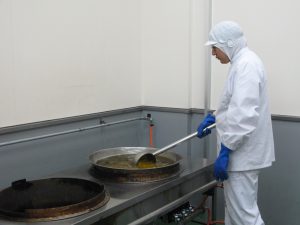
にんにく成分を抽出する様子
障害のある方たちがにんにくの加工を行う上で、課題と感じていた手荒れや効率性に配慮し、玉ねぎの皮むき器を製造している会社に、にんにくの皮むき器のアレンジを依頼、また安全面から包丁の使用を避けるために、にんにくの根を切るステンレス性の爪切りのような道具を鉄工所に製作してもらうなど、多様な主体の協力を得ながら、設備等の整備を進めました。また、商品化に向けては、関係者が地元高校に出前授業に赴き、想いを伝えていたこともあり、デザイン科の生徒にネーミング・ラベル制作のアイデアを募り、ついにガーリックオイル「ガァリック娘」が誕生しました。一次加工を担う障がいを持った人たちに、工賃が支払われる仕組みが生まれたことで、地域の作業所での活動が生まれ、現在も8名の雇用が維持されています。結果として年間7トンほど発生していた食品ロスの削減にも寄与する結果となりました。
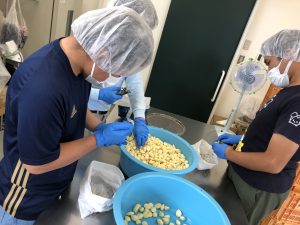
にんにくの根を切る作業
一方、「ガァリック娘」を製造する工程で、新たににんにくの残渣が2-3トン程、発生するようになっていました。オリーブオイルで加熱したにんにくを絞った後の残渣には風味や食味が残っていること、SDGsに取り組む企業から商品化に取り組みたいとの打診もあり、社会福祉協議会としても、8050問題や引きこもり、コロナ禍で働きたくても働けない人が柔軟に働ける場をつくりたいとの思いから、地産地消・アレルギー物質や添加物を使用していない商品として付加価値も確認した上で、2021年4月から新たな商品開発に取り組むこととなりました。
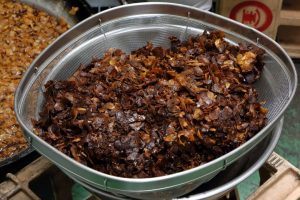
副産物となる残渣
この流れを受け、企業と社会福祉協議会に加え、にんにく生産者を交えた検討会が発足。油から残渣を引き上げた後の冷やす工程で、残渣が塊状に硬化し、粉砕が困難な副産物になることから、ガァリック娘の商品化にも関わった町内の鉄工所も協議の輪に加わりました。塊状に硬化した副産物を砕くための機械の試作や調整、意見交換、改善を繰り返す一方、企業では副産物の酸性劣化が進んでいないかの検証が進められました。5回の試行を繰り返し、ようやく機械が完成。再度、検討メンバーで工程の確認を行った結果、「粉砕作業→ふるい掛け作業→袋詰め作業」において長時間の作業が難しいことから、「ふるい掛け」の機械も製造し、残渣から新商品「どこでもガァリっ子」が誕生しました。商品開発、製造に関する一連の仕組みができたことにより、社会福祉協議会としても、更なる雇用を確保することができました。現在、「どこでもガァリっ子」は、地元の物産店、ホテルや旅館等の観光協会と商工会との連携により販売され、「ガァリック娘」を凌ぐ勢いで人気を集めています。両商品の販売で得らえた収益は、全て琴平町の地域福祉に還元されており、今後は、雇用を継続するための販売量増加を目標としています。
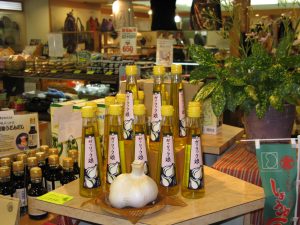
ガァリック娘販売の様子
地域の特産品を活用し、開発された「ガァリック娘」、「どこでもガァリっ子」。製造に携わるねむ工房はNPO法人格を取得。利用者は日々生き生きと加工に取り組んでいます。また、「どこでもガァリっ子」に携わる方たちの中には責任者を経て、イベントの接客ができるようになったメンバーもいます。関係者が出前授業で赴いた学校では、生徒がにんにくの植え付けや収穫作業等に参加、地域学習としての関わりも生まれています。福祉と環境、農業など多様な課題解決に向けた今後の取組にも注目です。
Local SDGs in Action: “Garlic Musume” Tackles Community Challenges Head-On!
Kagawa Prefecture boasts the third-highest garlic production in Japan, with much of that occurring in the town of Kotohira. However, every year about seven tons of garlic were simply being thrown out for failing to meet market standards. The Kotohira Council of Social Welfare, eager to provide employment opportunities and wage increases for people with disabilities, collaborated with the town of Kotohira, which was looking to create specialty products using vegetables, to begin an attempt at local product development.
The Kotohira Council of Social Welfare initiated talks with producers through matchmaking activities related to collaboration between agriculture, commerce and industry, and agreed to purchase garlic that would normally be discarded because it didn’t meet size, shape, or color standards for slightly higher than the market price. “Nemu Kōbō,” a local disability services and support organization that mainly manufactured wooden toys, took on the primary processing tasks such as splitting, peeling, slicing, and freezing. And, with the cooperation of Takahashi Shoten, which was aiming for local production and consumption of garlic oil, a new garlic oil was born. During the initial trial run, the goal was to deliver a 10 kg sample batch using the town’s kitchen. At first there was some concern about whether people with disabilities would be able to handle the work, but seeing their precise and reliable workmanship convinced the supervisors and producers alike, and the quality of the delivered product led to an increase in orders, eventually growing as large as 200 kg. As it became impossible to keep up while working out of the kitchen, Nemu Kōbō went so far as to outfit their own office with a garlic processing facility.

<Extracting Garlic Ingredients>
In order for people with disabilities to process garlic, and out of consideration for issues such as skin irritation and efficiency, a company that manufactures an onion peeler was asked to create a custom garlic peeler for them to use. Additionally, it was thought best to avoid knives for safety reasons, so an ironworks was commissioned to create a stainless steel tool similar to nail clippers for cutting garlic roots. In this way, improvements to the equipment were made with the help of various members of the community. As they prepared to bring the product to market, those involved with the project gave guest lectures at a local high school, sharing their thoughts and soliciting name and label ideas from the design department students, finally culminating in the creation of “Garlic Musume” garlic oil. With the advent of this system, where people with disabilities are paid wages to handle primary processing, there was an uptick in activity at local workshops, and even now eight individuals are maintaining their employment. It has also contributed to reducing the nearly seven tons of annual food loss mentioned earlier.

<Cutting Garlic Roots>
However, the Garlic Musume manufacturing process itself was producing around 2-3 tons of garlic residue. Realizing that this residue—which was left over after pressing garlic heated in olive oil—retained its flavor, there was a push by companies working on SDGs to find a way to commercialize it. The Council of Social Welfare also had an interest in establishing a flexible workplace to address the 8050 problem regarding middle-aged shut-ins living with elderly parents, as well as people who wanted to work but couldn’t due to the COVID-19 pandemic. After verifying the added value of a locally-produced, locally-consumed product with no allergens or additives, development of the new product began in April 2021.

<Residue Created as a Byproduct>
This led to the convening of a meeting between the companies, the Council of Social Welfare, and the garlic producers. To solve the problem of the residue hardening into difficult-to-break lumps after being removed from the oil and cooled, they enlisted the help of the same ironworks they worked with while developing Garlic Musume. Through repeated prototyping and revision, they developed a machine to break down the residue, while the companies determined whether or not it was undergoing acidic degradation. After five rounds of this, the machine was finally ready. The members from the previous meeting gathered again, this time confirming the difficulty associated with long hours of “crushing → sifting → packaging” operations. Consequently, a sifting machine was also manufactured, and the new product made from the garlic residue, “Dokodemo Garlikko,” was completed. The establishment of a complete system for product development and manufacturing allowed the Council of Social Welfare to secure additional employment opportunities. Currently, Dokodemo Garlikko is being sold with the cooperation of local shops, hotels and inns, tourism associations and chambers of commerce. Its popularity is growing rapidly, even surpassing Garlic Musume. All profits from the sale of both products are returned to the community welfare of Kotohira, with plans to increase sales volumes in order to provide continued employment opportunities.

ガァリック娘販売
<Garlic Musume For Sale>
“Garlic Musume” and “Dokodemo Garlikko” were developed from the region’s specialty products. Nemu Kōbō, involved in the manufacturing, has acquired NPO status. Every day, participants are energetically performing their work. And, among the those involved with “Dokodemo Garlikko,” some have even evolved into leaders adept at handling visitor interactions at events. At school visits by project members, students participate in garlic planting and harvesting, fostering community learning. This initiative stands out for its comprehensive approach, actively engaging with a broad spectrum of challenges beyond environmental sustainability, encompassing social welfare and agriculture as well.
从本地区开始的地方SDGs(可持续发展目标)“大蒜(Garlic)少女”以同时解决地区问题为目标
在以大蒜产量全国第三而闻名的香川县,琴平町一方面作为香川县大蒜的主要产地而栽培大蒜,另一方面,因为产品的规格未达到要求不能出货而被废弃大蒜每年有7吨。琴平町社会福利协议会为了解决残障人士就业和工资提高的问题,与以创造以蔬菜为原料的特色产品为目标的琴平町合作,开始在该町内进行商品开发的尝试。
琴平町社会福利协议会以农工商合作的对接活动为契机,与生产者进行协商,以略高于市场价的价格收购了因形状、大小、颜色等规格不合格而被废弃的大蒜。另外,以木制玩具制作为主要事业的町内残障人士福利服务事业所“NEME工房” 负责切分、削皮、切片、冷冻等的一次加工;在与以大蒜油的当地地产与消为目标的高桥商店合作基础上,创造出本地产的大蒜油。最初以10公斤样品为目标,在琴平町的厨房开始试制。起初也有人担心残障人士能否胜任这项工作,但是看到他们认真仔细地工作状态得到了该项目负责人和生产者的肯定,交货质量获得认可,订单量以100kg、200kg的速度不断增加。在这之后,由于在厨房中制造已经不足以满足订单量,NEMU工房的办公室也进行了能够进行加工大蒜的调整。

<提取大蒜成分的样子>
考虑到残障人士在加工大蒜的过程中会出现手湿疹和效率性的问题,所以委托生产洋葱削皮器的公司来设计大蒜削皮器。另外,从安全角度考虑,为了避免使用菜刀,在铁工厂的帮助下,制作了用于切断蒜根的像指甲剪一样的不锈钢工具,通过和各种机构的合作,推进设备的完善。另外,为实现商品化,相关人员还到当地高中进行授课,将相关的想法传递出去,并向设计科的学生征集命名和标签制作的想法,最终诞生了大蒜油“大蒜(Garlic)少女(商品名称)”。 在向负责一次加工的残障人士支付薪酬的制度诞生后,产生了在本地工作场所进行的活动,现在也维持着8人的雇佣。从结果来看,为减少每年产生的7吨左右的食品损失做出了贡献。

<切除蒜根的工作>
另一方面,在制造“大蒜(Garlic)少女”的工序中,又产生了2-3吨左右的大蒜残渣。用橄榄油加热的大蒜榨汁后的残渣还残留着蒜油的风味和大蒜的味道,也有致力于SDGs的企业提出要致力于商品化;社会福利协议会也提出了为解决8050问题(注:50多岁的拒绝与社会接触的子女由80多岁的高龄父母照顾的社会性问题)和拒绝与社会接触的人群,以及因为新型冠状病毒导致的想要工作而不能工作的人群创造能够灵活工作的场所,在确认了上述残渣有本地产消以及不添加过敏物质和食品添加剂的商品的附加价值基础上,从2021年4月开始了新商品的开发工作。

<作为副产品的食物残渣>
受此趋势影响,在企业和社会福利协议会的基础上,成立了大蒜生产者也加入的研讨会。由于残渣从油中提取后,经过冷却工序,会硬化成块状,成为难以粉碎的副产品,因此参与过“大蒜(Garlic)少女”商品化的町内铁工厂也加入了协商行列。在为了粉碎硬化成块状的副产物而反复进行机械的试制、调整、意见交换和改善的同时,在企业内部也在推进对副产物是否会酸性劣化的验证。经过5次反复试验,机器最终完成。讨论成员再次对工序进行了确认,结果发现“粉碎作业→筛选作业→装袋作业”的长时间作业很难,因此制造了“筛选作业”的机器,由此诞生了从残渣中提取新商品“到处都是蒜之子(商品名称)”。由于建立了商品研发、生产等一系列机制,社会福利协会也确保了更多的就业机会。现在,“到处都是蒜之子”由当地的物产店,酒店和温泉旅馆等观光协会和商工会联合销售,人气超过了“大蒜(Garlic)少女”。销售这两种商品所获得的收益将全部返还给琴平町的本地福利,今后的目标是为了继续雇用员工而增加销售量。

<贩卖大蒜(Garlic)少女的场景>
利用当地特产开发的“大蒜(Garlic)少女”、“到处都是蒜之子”,从事生产的眠工房(因此)取得了NPO法人(非盈利组织法人)资格。生产上述产品的人士每天都在积极地进行加工。另外,在参与“到处都是蒜之子”的成员中,也有一些成员经过担任负责人的工作,已经具备接待客户的能力。在相关人员前往授课的学校里,学生们参加了大蒜的种植和收获等工作,也产生了作为地区学习的关系。(大蒜(Garlic)少女)为解决福利、环境、农业等多种课题,今后将采取的措施也值得关注。
地域に根差すスーパーによる、サーキュラーエコノミー構築へのチャレンジ 株式会社フジ 松山デリカPC(プロセスセンター)/ A Local Supermarket Tackles the Circular Economy: Fuji Co., Ltd. Matsuyama Delica Process Center / 扎根地域的超级市场,构筑循环经济的挑战——株式会社FUJI Delica PC(流程中心)
社会的にSDGsが意識されるようになり、各所で循環型社会への転換が模索されていますが、私たちの暮しに関わる企業では、どのような対応が進んでいるのでしょうか?
愛媛県民にとって最も身近な企業の一つ、スーパーを展開する(株)フジ。同社の松山デリカPC*は、中四国のフジ全店約100店舗で販売する惣菜(弁当、サラダ、カット野菜等)を製造しています。(*2024年3月の組織変更により、(株)フジデリカ・クオリティが親会社に統合されて同センターとなりました)
同社は、日頃より廃棄物削減への取り組みを進めてきました。中食需要の拡大に対応し、出荷量増加による工場の増設、設備更新を行うタイミングで、製造工程で発生する食品残渣を有効活用するバイオマス発電プラントを導入し、2020年2月より本格運転をスタート。中四国民間企業初となる、自社食品残渣のみを利用するバイオマス発電プラントでは、1日当り約5トンの食品残渣から約800kWh/日を発電して、電力会社に売電しています。

バイオマス発電プラント全景。右側の建物は惣菜製造工場
■食品残渣を活用したメタン発酵バイオマス発電
導入したのはメタン発酵バイオマス発電プラント。惣菜等の製造過程で出る食品残渣を破砕し、水分調整後に大きな円筒形のメタン発酵槽に貯め、有機物を分解する際に発生するメタンガスを燃料にして発電が行われます。投入する食品残渣の量や種類による負荷の変動があるため、当初は処理が安定せず、メーカーからのアドバイスを得ながら運転を行ったそうです。これまでの運転ノウハウの蓄積により、現在では安定的な稼働が維持されています。食品残渣の投入以外は、ほぼ全自動であり、処理作業の手間は省けているそうです。
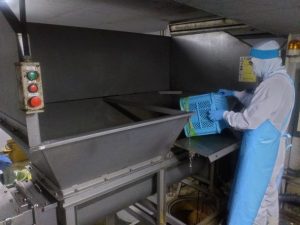
粉砕した食品残渣を発酵槽に投入します
このシステムの導入によって、食品残渣処理委託費約1,500万円(年間)が削減され、売電収入約1,100万円(年間)、廃液の処理費用や設備の維持費用約1,000万円(年間)との収支で、年間約1,600万円のコスト削減となり、10年強でプラント建設等の初期投資額(イニシャルコスト)が回収される目途となっています。
また、排水処理においては、2018年度に嫌気の環境下での排水処理で有機物をメタンガスとして回収するシステムを導入。メタンガスを熱エネルギー(蒸気)に転換して利用し、年間で約660万円のコスト削減効果が出ています。
■社会の反応を実感
「この工場からのゴミゼロを第一に考えており、環境負荷低減を実現していることをうれしく感じています。」と責任者は話してくださいました。
2020年度には愛媛県による優良循環型事業所として認定され、メディアで紹介される機会もあって、工場見学する自治体や企業が増え、循環型社会構築に寄与する企業として認知が高まったと感じているそうです。また、同じ認定企業との交流が進み、取引や連携へと発展しつつあり、ビジネスへの好循環も始まっています。
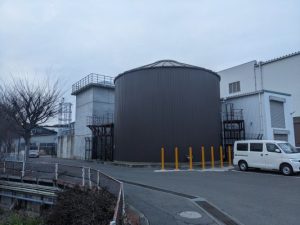
発酵槽(円筒形の建屋)
■さらなる環境負荷低減へ
惣菜等の販売は、売れ残りが食品ロスに直結してしまいます。そこでAIによる販売量の需要予測システムを導入し、AIの予測を基に販売計画を日々調整することによって、廃棄量を減らす効果を上げ、環境負荷低減に貢献するとともに、利益の確保につなげています。
さらに、食品トレーの重量削減による廃棄プラスチック削減にも取り組んでいます。同社も加盟する(一社)日本惣菜協会など業界団体や同事業者間でも、食品ロスや廃棄プラスチックの削減に取り組み、新技術の導入やノウハウの共有が進められているそうです。
社会やライフスタイルの変化に対応し、同社の惣菜製造事業は拡大しながら循環型社会構築に向けた多様な取組を展開していました。私たち消費者もこれらの取組を知り、相乗効果が高まるように、日々の「食」における行動を見直したいと感じました。
A Local Supermarket Tackles the Circular Economy: Fuji Co., Ltd. Matsuyama Delica Process Center
As society becomes more conscious about the SDGs, various sectors are searching for ways to transition to a circular economy. But what kinds of measures are being taken by businesses integral to our daily lives? Enter Fuji Co., Ltd., which operates a supermarket chain familiar to any resident of Ehime Prefecture. The company’s Matsuyama Delica Process Center produces ready-made meals (including bento boxes, salads, and cut vegetables) for sale in all of the approximately 100 Fuji stores in the Chugoku and Shikoku regions. (Due to an organizational change in March 2024, Fuji Delica Quality Co., Ltd. was fully absorbed into its parent company, Fuji Co., Ltd.)
Fuji has consistently strived toward reducing waste. When the company underwent factory expansion and equipment upgrades to increase production in response to an increase in demand for ready-made meals, it took the opportunity to install a biomass power plant that utilizes the food scraps left over from the production process. The plant came online in February 2020, marking the first time a private company in the Chugoku and Shikoku regions has operated a biomass power plant using only its own food waste. Every day it generates about 800kWh of electricity from roughly 5 tons of food scraps, which is then sold to the electric power company.

<Overview of the biomass power plant. The building on the right is the ready-made meal factory.>
■ Methane Fermentation Biomass Power Generation Using Food Scraps
The installed plant is a methane fermentation biomass power plant. Food scraps from the production of ready-made meals are pulverized, moisture-adjusted, and then put in a large cylindrical methane fermentation tank, where the decomposition of organic material produces methane gas used for power generation. At first the operation was unstable due to fluctuations in load depending on the amount and type of food scraps used, but the issue was resolved with guidance from the manufacturer. Accumulated operational know-how has enabled a consistent and, with the exception of loading the food scraps into the tank, mostly automated process, significantly reducing the amount of time and effort required.

<Pulverized food scraps being fed into the fermentation tank>
The installation of this system has cut food waste disposal costs by approximately 15 million yen per year, while bringing in about 11 million yen per year from electricity sales. Even with the roughly 10 million yen per year in additional costs from liquid waste disposal and equipment maintenance, that still comes out to a net annual cost reduction of about 16 million yen, meaning the initial cost of constructing the plant is expected to be recouped in just over ten years. Also, in fiscal year 2018 a system was installed that captures organic material as methane gas during wastewater treatment under anaerobic conditions. This methane gas is converted into thermal energy (steam) and used, resulting in an annual savings of about 6.6 million yen.
■ Feeling Society’s Response
“I truly feel this factory’s commitment to producing zero waste and the success we’ve already had at reducing our environmental impact is something to be proud of,” says the person in charge. In fiscal year 2020, the company was recognized as an Excellent Circular Business Operation by Ehime Prefecture, resulting in increased media coverage and interest from local governments and businesses in conducting factory tours, and enhancing its reputation as a company contributing to building a circular economy. What’s more, exchanges with other recognized companies are opening the door to new deals and collaborations, initiating a positive business feedback loop.

<Fermentation Tank (Cylindrical Building)>
■ Reducing Environmental Impact Even Further
When ready-made meals go unsold, it directly contributes to food loss. To combat this, Fuji has implemented an AI-based sales forecasting system, allowing them to reduce food loss by adjusting their sales plan on a day by day basis. This has helped reduce their environmental impact and secure profits. Efforts are also underway to reduce plastic waste by cutting down the weight of food trays. And, they are working with industry groups like the Japan Ready-made Meal Association (of which they are a member) and fellow retailers to reduce waste across the sector by promoting the introduction of new technologies and sharing know-how.
As society and lifestyles evolve, Fuji is expanding their ready-made meal business while simultaneously enacting various initiatives aimed at building a circular economy. I hope that by learning about these initiatives, we consumers are inspired to reconsider our own daily food-related behaviors and do our part to make their efforts more effective.
扎根地域的超级市场,构筑循环经济的挑战——株式会社FUJI Delica PC(流程中心)
随着社会意识到SDGs的重要性,各个地方都在摸索向循环型社会转变,与我们生活相关的企业在采取怎样的应对措施呢?经营超市的㈱FUJI是爱媛县民最熟悉的企业之一。该公司的株式会社FUJI Delica PC是为中四国地区富士全部100多个店铺制造销售用的熟食(便当、色拉、切好的蔬菜等)的公司。(根据2024年3月的组织架构变更,㈱FUJI Delica Quality被母公司合并成为该中心)。
该公司从平时都注意废弃物的削减。以应对在家食用的方便食品需求的扩大,以及因为出货量扩大而增设工厂、更新设备为契机,该公司导入了有效利用制造工程中产生的食品残渣的生物发电设备,从2020年2月开始正式运行。这是在中四国民间企业首个只利用本公司食品残渣的生物质能的发电设备,每天从约5吨的食品残渣中发电约800千瓦时,卖给电力公司。

<生物质能发电设备的全景。右侧的建筑物为熟食制作工厂>
■利用食品残渣的甲烷发酵生物质能发电
该公司导入的是甲烷发酵生物质能发电设备。该设备将熟食等制作过程中产生的食品残渣破碎,经过水分调整后储存在巨大的圆筒形的甲烷发酵槽中,将分解有机物时产生的沼气作为燃料进行发电。由于投入的食品残渣的数量和种类会造成负荷的变动,最初的处理效果并不稳定,在听取制造商的建议的同时进行运转操作。从此以后,由于运转设备的经验积累,现在已经实现稳定的运转。除了食品残渣的投入以外,几乎都是全自动的,省去了处理工作的麻烦。

<将粉碎的食品残渣投入发酵槽>
通过导入这个系统,减少了食品残渣处理的委托费用约1,500万日元(年),售电收入约1,100万日元(年),废液的处理费用和设备的维护费用约1,000万日元(年),实现每年减少支出约1,600万日元,实现10多年时间完全回收设备建设初期的投资额(初始成本)的目标。另外,在废水处理方面,2018年度导入在厌氧环境下的废水处理过程中将有机物转化为沼气回收的系统,将沼气转换成热能(蒸汽)加以利用,每年可消减约660万日元的成本。
■感受社会的反馈
负责人介绍说“我们首先考虑的是工厂垃圾的零排放,实现环境负担的降低,对此我们感到很高兴。” 2020年度该公司被爱媛县认定为优良循环型事业所,有机会在媒体上进行了介绍,参观工厂的自治体和企业也在增加,作为循环型社会构建贡献企业的认知也在提高。另外,获得同一认证企业之间的交流也在不断推进,逐渐向交易和合作的方向推进,商业上的良性循环也已经开始。

<发酵槽(圆筒形建筑物)>
■进一步降低环境负荷
熟食等的销售,卖不完会直接导致食品损失。因此导入了基于人工智能的销售量需求预测系统,根据人工智能的预测每天调整销售计划,实现提高减少废弃量的效果,为降低环境负荷做出贡献的同时,也确保了利润。在此基础上,通过减少食品托盘的重量等工作来减少废弃塑料。该公司也加入的日本熟食协会等业界团体和同事业者之间,也致力于减少食品损失和废弃塑料的事业,在新技术的引进和经验的共享等方面持续推进。
为适应社会和生活方式的变化,该公司在熟食生产事业不断扩大的同时,为构建循环型社会开展了多种多样的工作。我们消费者感到在知道这些工作的同时,为了提高协同效果,想要重新审视每天在“饮食”方面的行为。



